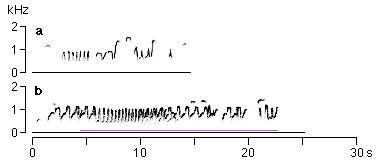
|
| |
Hoolock hoolock and H. leuconedys |
Short phrases of bi-phasic hoots ("ow-wa"), simple hoots, high pitched eeks, and low pitched growls. Bi-phasic hoots consist of notes alternatingly produced during exhalation and inhalation, as in Hylobates agilis (contra Haimoff, 1984). Short phrases are produced by either sex. Apparently no sex-specific notes in song repertoire of this species. Female great call with an acceleration-type climax, like H. moloch, of moderate speed, usually becoming slower near end. Great call notes mainly bi-phasic. Male usually begins vocalising halfway through the great call. Mated pairs typically produce duet song bouts only.
No vocal differences are known to occur between the western hoolock (Hoolock hoolock) and the eastern hoolock (H. leuconedys).

a. male short phrases (Kunming Inst. Zool., China, Oct. 1988, rec: Lan Daoying)
b. great call sequnce consisting of female great call with overlapping male contributions (Kunming Zoo, China, 27 July 1990)